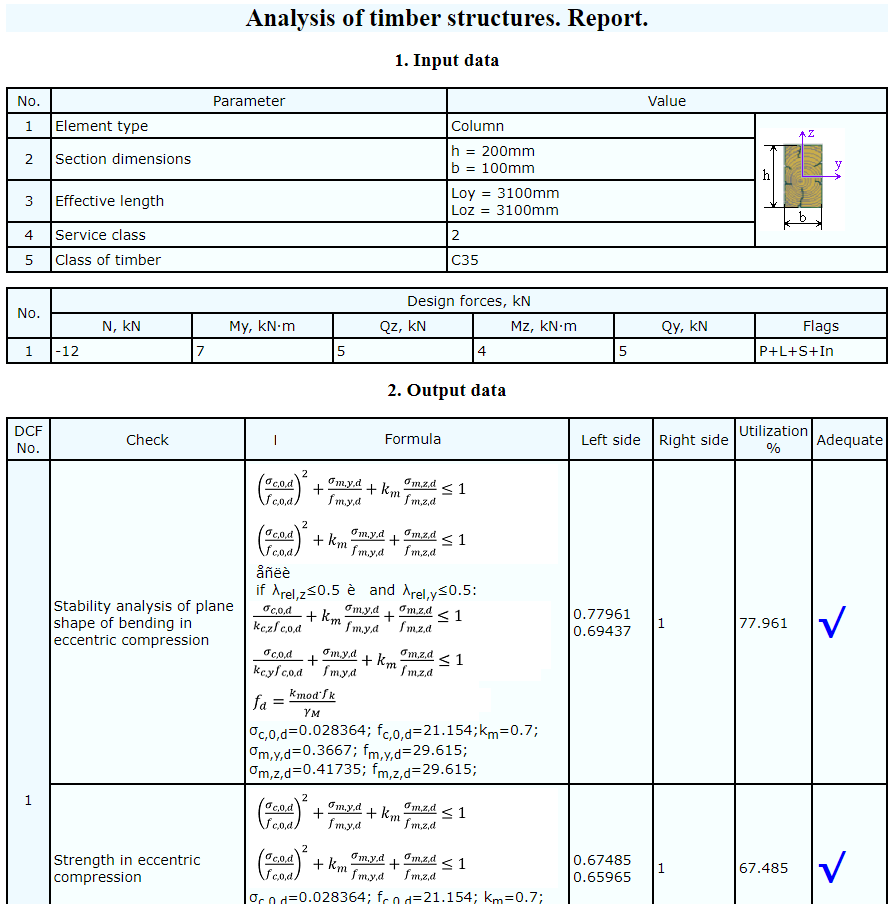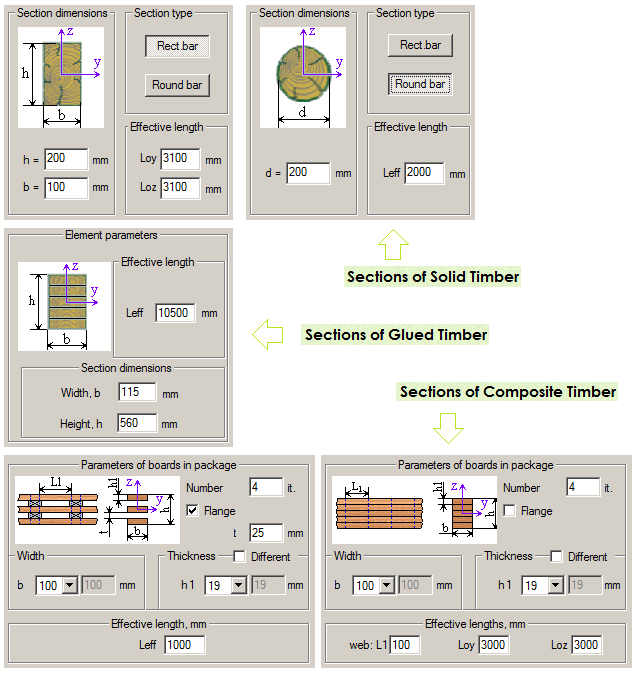Eurocode 5. Timber structures
LIRA-FEM* software supports a variety of national building codes, as well as European standards (Eurocodes) and national annexes to Eurocodes for Ukraine, the Republic of Kazakhstan, and the Republic of Belarus.
Eurocode 5. Timber structures
Analysis of timber structures according to Eurocode 5 in ESPRI 2020
Analysis of timber structures, selection and verification of timber sections according to Eurocode 5 in ESPRI 2020:
- EN 1995-1-1:2004. Eurocode 5: Design of timber structures - Part 1-1: General rules. General rules and rules for buildings)
The ESPRI software contains a set of reference and calculation programs (modules) organized into chapters. The 'Timber structures' chapter includes modules for calculation of solid, glued and composite sections of timber structures according to Eurocode 5. The modules in this chapter are mentioned to calculate the load-bearing capacity of timber structural elements according to EN 1995-1-1. The calculation is made with account of the nature and duration of the loads. During the calculation, the utilization ratio % of the section is determined for each check. A report is generated based on the calculation results.
Checks for cross-sections in analysis of timber structures according to Eurocode 5
The tables contain lists of limit state checks for design elements of column, beam and truss types. The utilization ratio % of the section for each check is determined during the calculation.
Checks for beams according to Eurocode 5
|
Check |
Formula in |
|
Strength in bending |
6.11, 6.12, 2.14 |
|
Strength in bending (chipping) |
6.13, 2.14 |
|
Stability analysis of plane shape of bending |
6.33 |
|
Strength in local compression at supports |
6.3 |
Checks for columns according to Eurocode 5
|
Check |
Formula in |
|
Strength in eccentric tension |
6.17, 6.18, 2.14 |
|
Strength in eccentric compression |
6.19, 6.20, 2.14 |
|
Strength in bending (chipping) |
6.13, 2.14 |
|
Stability analysis of plane shape of bending in eccentric compression |
6.23, 6.24 |
Checks for trusses according to Eurocode 5
|
Check |
Formula in |
|
Strength in axial tension |
6.1, 2.14 |
|
Strength in axial compression |
6.2, 2.14 |
|
Stability analysis of plane shape of bending in axial compression |
6.19, 6.23 |
Input parameters for the analysis of elements in timber structures
- Section type (solid, glued, composite). Each type of section has its own module for calculation: Solid sections of rectangular and round beams of timber structures; Glued sections of timber structures; Composite sections of timber structures.
- Type of element (beam, column, truss). Each type of element has its own list of necessary parameters that describe behaviour of the structural element.
- Design combinations of forces. The type of element in timber structure is related to the design forces that can be defined for it:
- The type of load under which the design forces are generated (dead, live, short-term, instant, medium duration).
- Dimensions of the cross-section. For a solid section - width b and height h of a rectangular cross-section or diameter d of a circular cross-section. For glued section - width b and height h of a rectangular section. The dimensions of the composite section are determined by the number and parameters of the boards in the package - width b of the cross-section and thickness hi of the boards in the package. The thickness is defined different for each board or the same for all boards in the package. If there are spacers between the boards of the package - thickness of spacers t.
- Effective length of the element Leff (for beams or circular sections); Loy, Loz in the corresponding planes (for rectangular columns and truss elements). Effective length of the shaft L1 between the fasteners of composite sections (for rectangular columns and truss elements).
- Timber class. For solid and composite sections - C14...C50, D30...D70. For glued sections - GL24h...GL32h, GL24c...GL32c.
- Service class of the structure (1, 2, 3).
- Eccentricity ey, ez in the appropriate planes (for columns and truss elements).
- The width of the support element when beam is calculated in the local compression at supports.
- Type (nails, dowels) and dimensions of fasteners (diameter or thickness) for glued section.
|
Element type |
Type of force |
|
Beam |
Bending moments My, Mz, shear forces Qz, Qy |
|
Column |
Axial force N, bending moments My, Mz, shear forces Qz, Qy |
|
Truss |
Axial force N |
Evaluate the software
If you have any doubt, download the Demo version and evaluate the program or contact our Support Team for more details.



